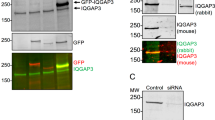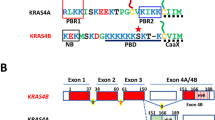Abstract
Harvey (Ha-MSV) and Kirsten (Ki-MSV) murine sarcoma viruses induce tumours in animals and transform various cells in culture because of the expression of the ras oncogene product, p21 (ref. 1). Proto-oncogenes homologous with these genes are highly conserved evolutionarily2 and activated ras oncogenes have been detected in many human cancers3–7. Whether c-ras oncogenes are directly responsible for human carcinogenesis is uncertain; however, it is clear that p21 mediates virus-induced transformation, although by an unknown mechanism. Epithelial and fibroblast cell lines transformed with Ha-MSV and Ki-MSV express p21 (ref. 8) and exhibit reduced adenylate cyclase activity9,10. Like the guanine nucleotide regulatory proteins, Ns and Ni, which mediate stimulation11 and inhibition12, respectively, of adenylate cyclase, p21 is a membrane-associated GTP binding protein, which exhibits GTPase activity13–15. These similarities suggest that p21 and the adenylate cyclase regulatory proteins are related in cellular function, and that p21 depresses adenylate cyclase by inhibiting the activity of Ns or acting as Ni. We have therefore now examined the structural and functional similarities between p21 and Ns and Ni and find no evidence that p21 regulates adenylate cyclase activity by acting as one of these regulatory proteins.
This is a preview of subscription content, access via your institution
Access options
Subscribe to this journal
Receive 51 print issues and online access
$199.00 per year
only $3.90 per issue
Buy this article
- Purchase on Springer Link
- Instant access to full article PDF
Prices may be subject to local taxes which are calculated during checkout
Similar content being viewed by others
References
Shih, T. Y., Weeks, M. O., Young, H. A. & Scolnick, E. M. J. Virol. 31, 546–556 (1979).
Chang, E. H., Gonda, M. A., Ellis, R. W., Scolnick, E. M. & Lowy, D. R. Proc. natn. Acad. Sci. U.S.A. 79, 4848–4852 (1982).
Yuasa, Y. et al. Proc. natn. Acad. Sci. U.S.A. 81, 3670–3674 (1984).
Shih, T. Y. & Weeks, M. O. Cancer Invest. 2, 109–123 (1984).
Shimizu, K. et al. Nature 304, 497–500 (1983).
Tabin, C. J. et al. Nature 300, 143–152 (1982).
Capon, D. J. et al. Nature 304, 507–513 (1983).
Willingham, M. C., Pastan, I., Shih, T. Y. & Scolnick, E. M. Cell 19, 1005–1014 (1980).
Beckner, S. K. FEBS Lett. 166, 170–174 (1984).
Andersen, W. B. & Pastan, I. Adv. Cyclic Nucleotide Res. 5, 681–697 (1975).
Northup, J. K., Smigel, M. D., Sternweis, P. C. & Gilman, A. G. J. biol Chem. 258, 11369–11376 (1983).
Katada, T., Bokoch, G. M., Northup, J. K., Ui, M. & Gilman, A. G. J. biol. Chem. 259, 3568–3577 (1984).
Shih, T. Y., Papageorge, A. G., Stokes, P. E., Weeks, M. O. & Scolnick, E. M. Nature 287, 686–691 (1980).
Gibbs, J. B., Sigal, I. S., Poe, M. & Scolnick, E. M. Proc. natn. Acad. Sci. U.S.A. 81, 5704–5708 (1984).
Sweet, R. W. et al. Nature 311, 273–275 (1984).
Hattori, S., Ulsh, L. S., Halliday, K. & Shih, T. Y. Molec. cell. Biol. 5, 1449–1455 (1985).
Hurley, J. B., Simon, M. I., Teplow, D. B., Robishaw, A.J.D. & Gilman, A. G. Science 226, 860–863 (1984).
Shih, T. Y. et al. J. Virol. 42, 253–261 (1982).
Furth, M. E., Davis, L. J., Fleurdelys, B. & Scolnick, E. M. J. Virol. 43, 294–304 (1982).
Sternweis, P. C. & Gilman, A. G. J. biol Chem. 254, 3333–3338 (1981).
Sefton, B. M., Trowbridge, I. S., Cooper, J. A. & Scolnick, E. M. Cell 31, 465–474 (1982).
Bokoch, G. M., Katada, T., Northup, J. K., Ui, M. & Gilman, A. G. J. biol. Chem. 259, 3560–3607 (1984).
Todo, Y. et al. Cell 40, 27–36 (1985).
Gilman, A. G. Cell 36, 577–579 (1984).
Lochrie, M. A., Hurley, J. B. & Simon, M. I. Science 228, 96–99 (1985).
Kahn, R. A. & Gilman, A. G. J. biol. Chem. 259, 6228–6234 (1984).
Northup, J. K., Sternweis, P. C. & Gilman, A. G. J. biol. Chem. 258, 11361–11368 (1983).
James, R. & Bradshaw, R. A. A. Rev. Biochem. 53, 259–301 (1984).
Author information
Authors and Affiliations
Rights and permissions
About this article
Cite this article
Beckner, S., Hattori, S. & Shih, T. The ras oncogene product p21 is not a regulatory component of adenylate cyclase. Nature 317, 71–72 (1985). https://doi.org/10.1038/317071a0
Received:
Accepted:
Issue Date:
DOI: https://doi.org/10.1038/317071a0
This article is cited by
Comments
By submitting a comment you agree to abide by our Terms and Community Guidelines. If you find something abusive or that does not comply with our terms or guidelines please flag it as inappropriate.



